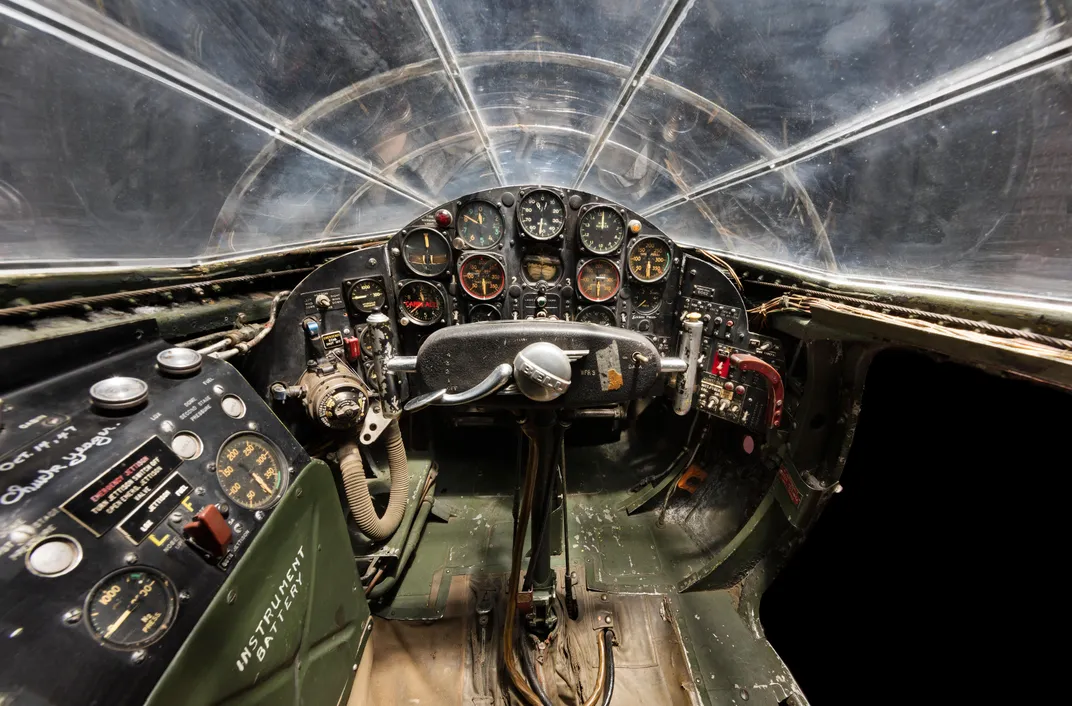Remember Chuck Yeager by Exploring the Plane He Flew to Break the Sound Barrier
In 1947, the pilot—who died Monday at age 97—made history by flying the Bell X-1 faster than the speed of sound
:focal(4385x2710:4386x2711)/https://tf-cmsv2-smithsonianmag-media.s3.amazonaws.com/filer/0b/8d/0b8d781c-05dd-49b6-8881-7c05eb090701/nasm-a19510007000_nasm2015-07319.jpg)
Charles “Chuck” Yeager, the first test pilot to fly faster than the speed of sound, died on Monday in Los Angeles, his wife Victoria announced on Twitter. He was 97.
Born to a large family in rural West Virginia, Yeager enlisted in the United States Air Force after graduating from high school in 1941. He emerged as a star pilot during World War II, once shooting down five German places in a single day and eventually logging more than 10,000 hours in the air, per Richard Goldstein of the New York Times.
But Yeager’s most famous feat took place in 1947, when the 24-year-old captain attempted—and accomplished—the seemingly impossible.
Planes had started approaching the speed at which sound waves travel through air in the 1930s, but aircrafts that did so often experienced mechanical troubles. By 1935, experts had raised the possibility of a “sound barrier”—a term that implied “a physical wall that could not be overcome,” as Nola Taylor Redd wrote for Space.com in 2017. Some scholars argued that the pressures exerted on an aircraft—and its pilot—at such speeds were simply too much to overcome.
With Yeager as its test pilot, the Air Force set out to challenge the limitations of this theory. In the mid-1940s, the organization began to develop what became the Bell X-1: a small, experimental aircraft powered by a four-chambered rocket engine and built to withstand 18 times the force of gravity.
Painted a shockingly bright orange, the plane cut a streak of color through the sky. Yeager nicknamed it “Glamorous Glennis” in honor of his first wife, who died in 1990.
During dry runs, the larger B-29 Superfortress dropped the X-1 as the crafts cruised over the Mojave Desert near Muroc Dry Lake, California. Over the course of several test flights, Yeager slowly pushed the bullet-shaped plane closer and closer to the famed sound barrier.
Then, on October 14, 1947, the pilot accelerated to a speed of 700 miles per hour—or Mach 1.06—at an altitude of 43,000 feet. As he passed the sound threshold, controllers on the ground heard a sonic boom thunder across the desert.
At the time, Yeager’s flight marked the highest velocity and altitude ever reached by an airplane.
“[It] demonstrated that aircraft could be designed to fly faster than sound, and the concept of a ‘sound barrier’ crumbled into myth,” notes the Smithsonian’s National Air and Space Museum, where the neon plane is currently on display.
In the same year as his history-making flight, Yeager modestly described the trip as “nice, just like riding fast in a car.” The U.S. government kept his accomplishment a secret for a year, leading the world to believe that Great Britain had broken the sound barrier first, according to the Associated Press.
“After all the anticipation to achieve this moment, it really was a letdown,” the pilot recalled in his 1985 memoir, Yeager. “There should’ve been a bump in the road, something to let you know that you had just punched a nice, clean hole through the sonic barrier. … Later on, I realized that this mission had to end in a letdown because the real barrier wasn’t in the sky but in our knowledge and experience of supersonic flight.”
The Air Force presented the craft, dubbed the X-1 #1, to the Smithsonian Institution in August 1950. By the time of its “retirement,” the plane had completed 19 contractor demonstration flights and 59 Air Force test flights, including a March 26, 1948, mission during which Yeager attaining a speed of 957 mph (Mach 1.45) at 40,130 feet.
As Paul Glenshaw writes for Air & Space magazine, Yeager commanded a string of Air Force units between 1954 and 1971, flying 127 missions over Vietnam and serving across Europe and Asia. During the 1960s, he ran the Aerospace Research Pilot School—a training venture that found him embroiled in controversy over the admission of black pilot and astronaut hopeful Ed Dwight. Yeager retired from the Air Force in 1975 but remained active in the aviation community until his death.
In 1979, Tom Wolfe’s book The Right Stuff widely publicized the details of Yeager’s boundary-breaking plane ride. A subsequent 1983 film adaptation starring Sam Shepard as Yeager further cemented his status as a celebrity pilot.
Throughout his career, Yeager was a “good friend of the Smithsonian,” says Bob van der Linden, curator of air transportation and special purpose aircraft at the Air and Space Museum. (Read van der Linden’s reflection on Yeager’s passing here.)
“For decades, he visited the [museum] on or about the anniversary of his supersonic flight and regaled the packed theater with stories of his extraordinary career,” the curator adds. “During one of his visits, Deputy Director Donald Lopez, a friend of Yeager’s from their time together as test pilots, arranged for Yeager to climb in the cockpit of the X-1 high above the floor of the Boeing Milestones of Flight Hall. After that remarkable visit, Yeager generously donated his collections of personal items, including his flight jacket and other memorabilia.”
Today, air travel enthusiasts can explore a three-dimensional model of the machine on the museum’s website or even 3-D print their own scaled-down version of the plane.
/https://tf-cmsv2-smithsonianmag-media.s3.amazonaws.com/accounts/headshot/nora.png)
/https://tf-cmsv2-smithsonianmag-media.s3.amazonaws.com/filer/f7/b4/f7b4a096-61bc-45f8-8844-b15927d2a5ae/nasm-a19510007000_nasm2015-07347.jpg)
/https://tf-cmsv2-smithsonianmag-media.s3.amazonaws.com/filer/95/b4/95b4757d-34c5-459d-aedc-bfc603d1dcd1/nasm-a19510007000_nasm2015-07309.jpg)

/https://tf-cmsv2-smithsonianmag-media.s3.amazonaws.com/filer/00/e0/00e0c716-dba9-4b37-bfed-e0f24ab05986/2560px-chuck_yeager.jpg)
/https://tf-cmsv2-smithsonianmag-media.s3.amazonaws.com/accounts/headshot/nora.png)